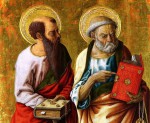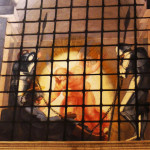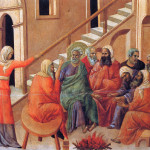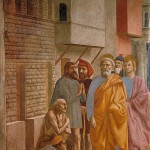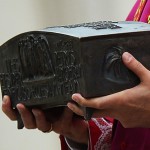Saint Apostle Peter
In Vatican, under the dome of Saint Peter’s Basilica, in a crypt, the remains of Saint Apostle Peter are resting – the first and one of the closest disciples of Jesus Christ.
Apostle Peter, who is also called Simon, or Cephas, the top apostle, prince of the apostles, the first Pope of Rome. He was born in Bethsaida of Galilee. He died a martyrs’ death in Rome in 64 (67) A.D.
Originally, Peter had a traditional Hebrew name Simon. The name Peter, which means rock, or stone, is pronounced in Aramaic as Cephas; and the apostle received it from Jesus Christ. Peter and his brother Apostle Andrew come from Bethsaida in Galilee. Their father was John, or Jonah in short. Peter and Andrew were fishermen and they lived at the Sea of Galilee (Lake Tiberias) in Capernaum. From the Gospel of Mark chapter one we find out that Peter was married, we do not know his wife’s name, but his mother in law is mentioned in the text. Peter was godly and pious, but he was not specifically trained in the Jewish Law. It is assumed, that before he met Christ, Peter was a disciple of John the Baptist. Peter was one of the first ones called by Christ, along with his brother Andrew, and with brothers James the Greater and John the Evangelist, sons of Zebedee.
Peter is always mentioned first in the list of the twelve apostles. According to the Gospels, Peter together with James and John, sons of Zebedee, belonged to the closest disciples of Jesus. These three were present when Jairus’ daughter was resurrected; they witnessed the Lord’s Transfiguration, and were with Jesus in the Garden of Gethsemane during His prayer. In some episodes of the Gospels, where the disciples of Christ were involved, only Peter is mentioned by name. Peter confessed Jesus as the Messiah, and Jesus called him blessed, emphasizing that his confession was the result of the Father’s revelation, and gave Simon the name Peter, promising that upon this rock His Church will be built, and the gates of Hades shall not prevail against it, and He also promised to give to Peter the keys of the Kingdom of the Heavens (they symbolize His own authority), and the authority to “bind and loose” in the heavens. The authority to bind and loose in the heavens is promised to all the apostles and mainly it is the authority to forgive sins or to leave them without forgiveness – “If you forgive the sins of any, they are forgiven them; if you withhold forgiveness from any, it is withheld.” (Gospel of John 20:23).
Jesus stayed in Peter’s house in Capernaum, where He healed his mother in law from fever. Jesus also used Peter’s boat during His preaching in Galilee. It was Peter who Jesus discussed the matter of the temple tax with. Believing in Christ, Peter walked towards the Saviour on water, but when his faith was shaken he began to drown. It is often seen from the Gospels that on behalf of all apostles Peter asked Jesus questions concerning the contents of His teaching. During one of the conversations Peter asked Jesus to explain the meaning of His words, when He said, “it is not what goes into the mouth that defiles a person, but what comes out of the mouth; this defiles a person.” (Gospel of Matthew 15:11, 15); Peter also asked Jesus to make clear how many times we have to forgive the sinning one (Gospel of Matthew 18:21), and what will be the reward for those, who, having abandoned everything, followed Jesus (Gospel of Matthew 19:27; Gospel of Mark 10:28; Gospel of Luke 18:28).

Filippino Lippi. Matryrdom of Apostle Peter and disputation with Simon Magus in front of Nero. 1481-1482. Fresco. Florence.
At the Last Supper apostle Peter tried to stop Jesus from washing his feet and wanted to find out, who would betray Jesus. And Jesus prayed for Peter so that Peter’s faith would not come short, and commanded him to confirm the brothers in their faith. Peter promised to follow Jesus even unto death, but Jesus prophesied to Peter that he would deny Him. During the Prayer at Gethsemane, when all the disciples were falling asleep, it was Peter, who Jesus rebuked for it. When Jesus was being arrested, Peter cut off an ear of the high priest’s servant, but Jesus commanded Peter to put the sword back into the sheath, since it was necessary to fulfil that which the Father had purposed (Gospel of John 18:10-11). Despite the triple denial of Peter predicted by Jesus, which was due to the lack of faith, and not to the lack of courage, Jesus after His resurrection appeared to him before He appeared to other disciples. According to the Gospel of John, Peter was first to enter into Jesus’ tomb. Peter made up for his triple denial by his triple confession of love to Christ. Jesus entrusted to Peter to shepherd His sheep and predicted for Peter a martyr’s death.
After Christ’s ascension, Peter took the lead among the apostles. He presided at the apostles’ gathering to choose the twelfth apostle instead of Judas Iscariot. Beginning from the Day of Pentecost, Peter preached the resurrection of Christ and healed people in Jerusalem. By the order of the high priest, Peter and other apostles were arrested twice. The second time, they were rescued in a miraculous way. When he spoke before the Sanhedrin, which tried to forbid the apostles from preaching Christ’s resurrection, Peter boldly said, “Which is right in God’s eyes: to listen to you, or to Him?” (Acts 4:1-22; 5:17-42). Together with John, Peter went to Samaria, where he strongly rebuked Simon the Sorcerer, who tried to obtain the Holy Spirit from the apostles in exchange for money. Then Peter visited the churches in Galilee, Lydda, Sharon, and Joppa (modern Jaffa). In Lydda Peter healed paralyzed Aeneas, and in Joppa he raised Tabitha from the dead. In Caesarea Peter allowed centurion Cornelius to be baptized, together with Cornelius’ relatives and friends, thus opening the way to repentance and salvation for the gentiles. Later, Peter returned to Jerusalem, where during the persecution raised up by Herod Agrippa I, he was put into prison again, but then he was released in a miraculous way. Apostle Peter participated in the Jerusalem Council, where it was discussed whether the gentiles, who were baptized, necessarily needed to practice circumcision and other ritualistic ordinances of the Jewish law.
Apostle Paul mentions his meeting with Peter in Jerusalem three years after he was converted to Christianity, and then during the Jerusalem Council, and in Antioch (Galatians 1:18; 2:1-14). Among other things, Paul also mentions his argument with Peter in Antioch, concerning whether the Christians had to keep the Judaic law. Paul also says that Peter on his mission journeys was accompanied by “a sister, a wife” (1 Corinthians 9:5).
Two epistles of Peter are included in the canonical text of the New Testament, but modern scholars question the authorship of the Second epistle of Peter, and some – even his authorship of the First epistle. In 1 Peter, from Peter’s person it is mentioned that he was staying in Rome, which is metaphorically called “Babylon,” which was a name commonly used in the early Christian tradition.
The early Christian sources indicate that Peter was in Rome and suffered a martyr’s death there during the persecution of the Christians under Emperor Nero. Pope Clement I and Ignatius of Antioch testified about the martyrdom of Peter and Paul, and Irenaeus of Lyon asserts that these apostles established the Church in Rome. While speaking about the authority of the Church in Rome’s teaching, Tertullian points out that Peter was made equal with Christ in the form of his suffering, and for the first time connects the authority of the Church in Rome with the words spoken by Jesus Christ in the Gospel of Matthew, chapter 16, verses 16 through 18. In another place, Tertullian directly testifies that Peter was sentenced to the cross, he was bound by another one’s hand, and crucified.
Eusebius of Caesarea writes that Peter, who was called the first apostle for his courage, under emperor Claudius preached the Kingdom of the Heavens in Rome, and mentions that Peter met with Philo of Alexandria there. Eusebius shares the testimonies of the bishop of Corinth Dionysius about the Church of Rome being founded by Peter and Paul, and about their martyrdom, and of presbyter Caius, who indicated that the “trophies” of Peter and Paul rest in Rome, at the Vatican Hill and on the Ostian Way respectively. In the testimony of Clement of Alexandria, he presents his opinion that the Gospel of Mark was written from the words of Peter, who preached the gospel in Rome. Eusebius also mentioned that Peter was crucified with his head down.
According to the later information of Jerome, Peter came to Rome with the purpose of refuting Simon Sorcerer’s preaching in the second year of emperor Claudius’ reign, and took the bishop’s cathedra there until the last year of Nero’s reign. According to the order of emperor Nero, apostle Peter was crucified on the cross for converting to Christianity two of Nero’s wives. Peter wanted to be crucified head down, because he considered himself not worthy of being crucified in the same way like Jesus. According to Jerome’s testimony, Peter was buried in Rome at the Vatican Hill near the triumphal way, where the Cathedral Basilica of Saint Peter is now standing.
During the pontificate of Pope Pius XII, in 1939, archaeological excavations started under Saint Peter’s Basilica. Prior to that, no one dared to prove what was there under the basilica, although, according to the legends, the present basilica was built on a spot, where the gardens of Nero’s circus once were, and where in the times of Constantine the Great the first Basilica stood, erected above the site, which was known and venerated even from the end of the first century of Common Era.
During the excavations, which lasted for over ten years, the ancient Roman burials were found. In 1950, Pope Pius XII announced, that the tomb of apostle Peter was discovered, and later, in 1952, a detailed report of the archaeological researches was published, where it was stated that as early as in the first century, one of the tombs of the ancient cemetery was especially venerated.
The further works were carried out under Italian archaeologist Margherita Guarducci. At the site of the excavations, certain graffiti were found on stones, related to this cemetery. After these graffiti were read, it became clear, that they contained requests to Peter, whose name was sometimes mentioned alongside with the names of Christ and of Mary. One of the inscriptions, dating from the second century and written in Greek, plainly says, “Peter is here.”
Professor Guarducci discovered some human remains near this inscription. The subsequent analysis of the remains showed that they belong to one person, who was robust, and who died at his old age. This description matches apostle Peter.
This article used the materials from the Catholic Encyclopaedia.

